They came, they conquered and their lasting effect on Britain is still visible to this day. From ancient forts, roads and walls, to villas, palaces and spas, discover Britain’s Roman legacy. By Penelope Rance
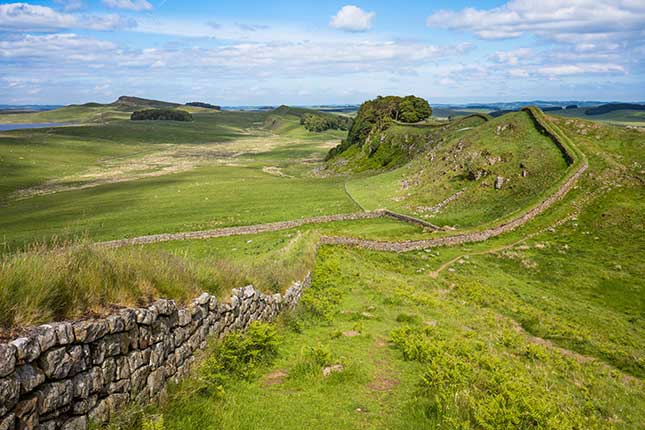
Technology, architecture, language, government, town planning – even a sense of national identity. The depth of the Roman influence on the British Isles was such that it survives to this day, seemingly unmatched by that of any of the invading forces that followed them. But then, the majority of those invaders, and the subsequent ruling elites, wanted nothing better than to be Roman themselves.
These heirs to the Roman ideal – Saxons, Danes, Normans, Plantagenets, Tudors, Georgians and Victorians – all tried to establish Britain as part of a wider empire, drawing on the example set by those first imperial overlords.
Their efforts to regain the military glory and sheen of civilisation shaped the history of these islands, which took their first steps towards unity in 43AD. For more than anything else, the Romans left Britainnia with the sense of what it is to be British, in the oldest meaning of the word. Thus the Welsh claim direct decent from the original Britons, while the Scottish remain fiercely proud of the failure of Rome to subdue the Picts in the north.
“We don’t know what the tribes called themselves – we only know what the Romans called them,” says Christine Medlock, director of Fishbourne Roman Palace. “They created a Celtic empire by naming them. The Romans put an identity onto the locals. We only know about them through their writings.”
But the relationship was by no means all give and no take. Welsh tin and Cornish gold provided valuable trade opportunities, and British jet, pearls, wool and hunting dogs were all prized. The islands provided soldiers for the legions, slaves for the cities, an expansion of the Empire to the end of the known world, and a proving ground for future Emperors. Julius Caesar and Claudius both built their power bases on popular campaigns in the islands at the edge of the western sea. In many ways, Rome’s power was built on British soil.
Roman influence in Britain
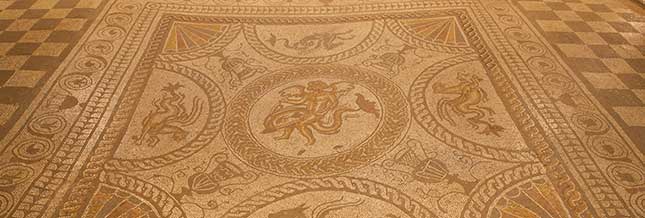
Roman influence began in 55BC with Julius Caesar’s first, ineffectual invasion. After successes in Gaul, he pushed on for a final victory, ill prepared and undermanned. He came, he saw, and he departed, not even leaving a garrison behind him. The Senate was impressed, the natives were not. The following year he tried again, and succeeded in coercing some tribal leaders into owing tribute to Rome.
For the next century, the relationship was one largely based on trade and diplomacy. Britain did not become a part of the Empire until another man needed a military victory to shore up his power – Claudius sent Aulus Plautius to subdue Britain for him. Victories on the River Medway at Richborough and on the Thames, as far as Camulodunum (Colchester), brought the south of the islands into the Empire and, while the far north was never conquered, over the next 30 years, the rest of Britannia was brought under Roman control.
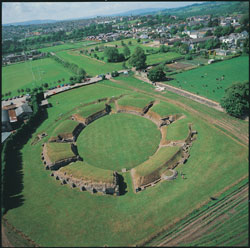 |
| Roman remains at Caerleon, Wales |
As the invaders marched through the kingdoms of the Celts, they founded forts, built roads, and established cities and palaces. The routes of the famously straight roads which cut their way across hills and valleys throughout Britain can still be traced today. The mighty north-south thoroughfare of Watling Street, now partly followed by the M1 motorway, was also used by Boudicca, Queen of the Iceni, to descend on Londinium (London) and Verulamium (St Albans) in 61AD.
“Roads were built by the army as a means of easing passage and were maintained by the local government,” says Emma Stuart, outreach officer at the Corinium Museum, Cirencester.
“In Cirencester, the second largest administrative centre in Britain, three major Roman roads converged – Ermine Street, Akeman Street and the Fosse Way.” At Pickering in Yorkshire you can still stand on the cobbles of Wheedale Roman Road.
Military Legacy
The military legacy of the Romans is one of the most apparent. They brought with them new weapons, armour and tactics the like of which the native tribes had never seen. Hadrian’s Wall, begun in 122AD following the Emperor’s grand tour of Europe and finished just six years later, was raised to defend against the marauding Picts and Scots.
Although the Romans pushed farther north to Falkirk, where remains of the Antonine Wall can still be seen, Hadrian’s Wall became the effective border of the Empire, and one of the greatest pieces of military architecture in the Empire.
Heavily garrisoned as it was, Britain was a natural training ground for the Empire’s leading men. Its governors went on to become emperors, and it was a powerbase for a host of rebels. It also became home to a many of those who served there – Sarmatians, Thracians, Batavians. As men from the garrisons retired, they settled near to the forts, and cities grew up around their farmsteads. These can be identified today by their names – the suffixes ‘chester’, ‘caster’ and ‘ciester’ all signify Roman origins.
“Towns across Britain also ensured Roman culture was adopted by the indigenous British peoples,” says Emma Stuart. “Public buildings such as the amphitheatre and baths gave the locals place to spectate, exercise, relax and socialise.”
“If you lived in the Roman towns, you followed the Roman way of life, became Romanised and desired to become a Roman citizen,” says Jenny Hall, Department of Early London History and Collections at the Museum of London. ”There was a real mix of nationalities and religious beliefs all blending into a cultural melting pot.”
In their architecture, the Romans also brought their culture to bear in the native populace. The finest example of domestic living arrangements can be found at Bignor Roman Villa in West Sussex. Set on Stane Street, which once linked Novoimagnus Regnorum (Chichester) to London, it was composed of more than 70 buildings spread across four acres. Here you will find the most complete floor mosaics in Britain.
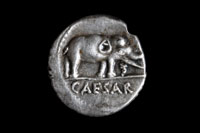 |
| A coin from the Corinium museum |
Fishbourne Roman Palace near Chichester reveals much about how the elite lived, with its underfloor heating system, baths, landscaped gardens and elegant decoration. “These were the first gardens in Britain,” says Christine Medlock. “The Romans introduced a different concept of the use of land. They’ve left behind a legacy in the beautiful mosaics and painted wall tiles.”
And with living conditions came lifestyle. Wooden tablets discovered in garbage pits at the fort of Vindolanda on Hadrian’s Wall – the oldest written record found in the country – show that the Romans established the lifestyle of the idle rich centuries before the Georgians made it their own.
Among the tablets are letters between the camp commander’s wife, Sulpicia Lepidnia and her friend Claudia Severa, wife of the commander at Housesteads. They reveal a level of boredom and loneliness that has been the lot of military wives down the centuries, along with descriptions of entertaining local dignitaries and travellers.
The Georgians also followed in Roman footsteps to Bath. The springs at Aquae Sulis were exploited for their healing powers 1,500 years before they became the favoured watering place of Regency bucks and belles. Our other waterworks also owe a debt to the Empire. Not until the Victorians was such an effective system of sewers again built in the country.
The Romans also gave Britain a new diet. “Their main legacy is in the foods they introduced and cultivated here,” says Jenny Hall. “They introduced such things as carrots, cucumbers, plums, cherries and better varieties of apples and pears, which have remained staple parts of the British diet.”
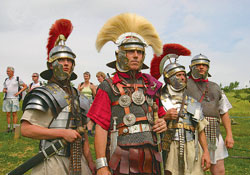 |
| Roman re-enactors |
Their tastebuds demanded the flavours of home, and what they couldn’t find on the native shores they imported. Rabbits, chickens, sweet chestnuts and Roman snails were also brought in to grace their tables. Mediterranean herbs were planted and vineyards established, which are today producing very palatable vintages.
And while English is not a Latinate language, we have inherited much of those early invaders’ vocabulary – part of what makes English such a versatile, descriptive language is it absorption and effortless combination of occupying tongues. Scandinavian, Germanic and Norman roots blend with Latin in our speech.
Although the early Roman rulers did little to impose their religious beliefs on the native pagans, religion would later form an important part of their legacy. Pantheistic in structure, the Roman belief system merely absorbed the local deities, morphing them into their closest counterpart. All this changed, at least officially, when Constantine, crowned Emperor at York, adopted the Christian religion. Seeing the one god as a powerful force, he scrawled the Chi-Rho symbol on his soldiers’ shields at the battle of Milvian Bridge in 312AD, and won a massive victory. In thanks, he declared Christianity the central religion of the Empire, establishing the Nicene Creed of the Catholic Church – making Britain the birthplace of Roman Catholicism.
For 400 years, Britain played an important role as part of the Empire. However, Barbarian attacks on the capital had weakened the Empire, and troops were pulled out of the west to help defend it. Constantine III led the legions into Gaul, leaving the Britons to face Saxon attacks alone. In 410, the remaining Romanised elite appealed to the Emperor Honorius for help. He responded that they should “look to their own defences”. The era of Roman Britain had ended.
Where to see Roman Britain
- Bignor Roman Villa, Pulborough, West Sussex: Excavated large Roman courtyard villa with world-class mosaic floors. www.bignorromanvilla.co.uk
- National Roman Museum, Caerleon, Newport, South Wales: The name Caerleon is derived from the Welsh for “fortress of the legion”. www.museumwales.ac.uk/roman
- Chedworth, Yanworth, nr Cirencester, Gloucestershire: Romano-British villa in lovely valley setting,with intricate mosaics and a local museum. www.nationaltrust.org.uk
- Corinium Museum, Cirencester: Roman mosaics, tombstones and sculpture reflecting Cirencester’s importance as the second biggest Roman town, Corinium, outside London. www.coriniummuseum.co.uk
- Fishbourne Roman Palace, Chichester, West Sussex: Excavated Roman Palace built in the 1st century ad. www.sussexpast.co.uk
- Hadrian’s Wall: Explore the 84-mile National Trail that follows this World Heritage Site, from Tyneside to the Solway Estuary in Cumbria. www.hadrians-wall.org
- Museum of London, London EC2Y: The Roman collection comprises some 47,000 objects (Roman inscription, pictured right), many of which were recovered during building works in the City of London. www.museumoflondon.org.uk
- Reculver Roman Fort (English Heritage), Herne Bay, East Kent: The remains of an important Roman ‘Saxon Shore’ fort. www.english-heritage.org.uk
- Roman Baths, Bath: Ancient thermal spa. www.romanbaths.co.uk
- Roman Tours, Wrexham: Tours of Roman Chester. www.romantoursuk.com
Related articles
|
Click here to subscribe!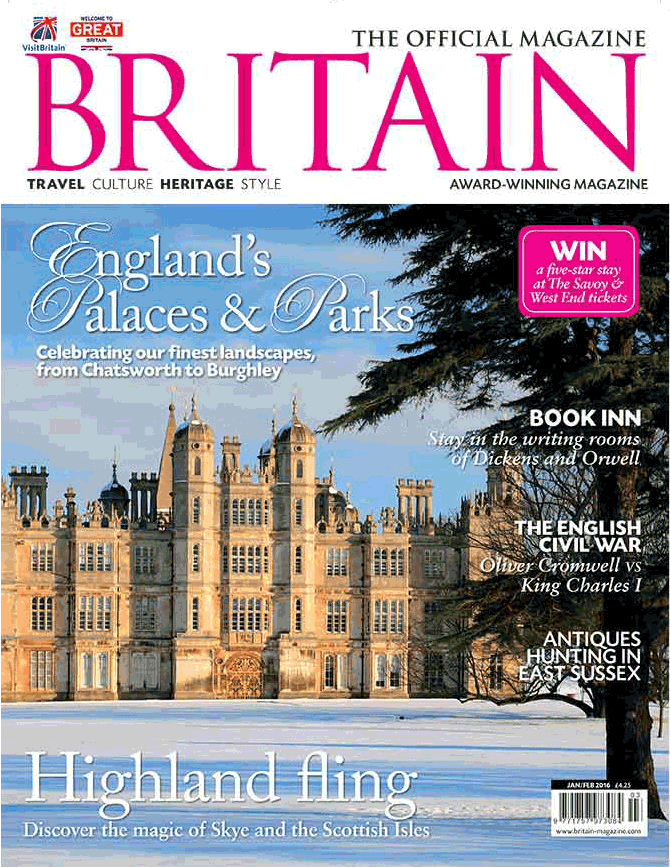 |
Download BRITAIN Magazine to your mobile today

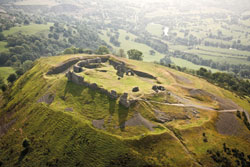




 © 2024
© 2024